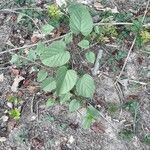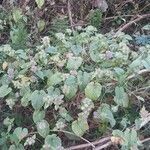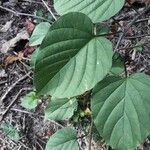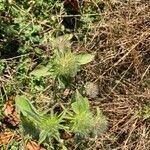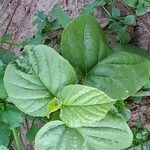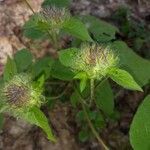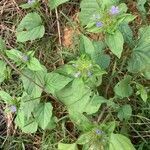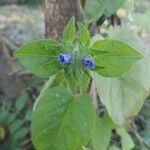Annual twiner; stems adpressed pilose with silky hairs.. Leaf-blade ovate, up to 6 cm. long and wide, acute to acuminate at the apex, acute to cordate at the base, sparingly adpressed pilose above and below, or glabrescent; petiole about 3.5 cm. long.. Flowers in dense hairy capitate cymes 2–3 cm. across, of a ferrugineous colour when dry; peduncles up to 15 cm. long, silky pilose above.. Outer bracts similar to the leaves but smaller, about 2 cm. long; inner becoming smaller and more hairy inwards, lanceolate or linear.. Sepals lanceolate, acute, subequal, densely and softly hairy, 5–7 mm. long.. Corolla blue, 1 cm. long.. Capsule 4–5 mm. in diameter, straw-coloured.. Seeds 4, brown, scabridulous, 2 mm. long.. Fig. 10, p. 36.
flowered but few open at one time, densely hirsute; sepals lanceolate, 10-15 mm long and 1-3 mm wide, acuminate, hirsute with yellowish brown trichomes; co-rollas mostly blue, some white, 1 cm long, interplicae glabrous; stamens subequal, the filaments basally glabrous; ovary subglobose, glabrous. Fruits capsular, enclosed in sepals and subfoliose bracts, globose, 4-5 mm in diameter, light brown, glabrous; seeds orange-brown, 2.5 mm long, glabrous.
A herb. It has a taproot. It has several stems. The stems are trailing. They are about 1 m long. They have flattened silky hairs. The leaves are simple and oval. They are alternate. They are 9 cm long by 6 cm wide. They are on slender stalks. The flowers are blue. They are in dense hairy heads. They are on long stalks. The fruit are round and pale yellow. There are usually 4 seeds.
Flowers in dense hairy capitate cymes more or less 2·5 cm. across, of a ferrugineous colour when dry, supported by reduced bract-like leaves with narrowing base, the inner ones becoming smaller, lanceolate or linear, and more hairy ultimately resembling the sepals; peduncles up to 12 cm. long, silky pilose above.
Leaf lamina ovate, oblong to broadly cordate, up to 9 × 6 cm., acute to acuminate at the apex, truncate to cordate at the base, glabrescent or more or less pilose with brownish or white hairs, ciliate; petiole slender, up to 4·5 cm. long, usually much more densely pilose than the blade or stem.
Vines; stems herbaceous, hirsute throughout. Leaves ovate to broadly ovate, 3-10 cm long and 1.5-6 cm wide, basally cordate, apically acute or abruptly acuminate, glabrescent. Flowers in dense head-like cymose inflorescences, many-
A widespread weed in tropical Amer. and s. U.S., has been collected as far n. as n. Ill. and se. Va. It will key to Calystegia, from which it obviously differs in its densely cymose-capitate clusters of blue fls ca 1 cm.
Stems several from the base, twining or trailing, occasionally suberect, up to about 85 cm. long, appresed pilose with silky hairs, usually brownish.
Twining annual herb. Leaves and stems distinctly pubescent or hairy. Flowers crowded into bracteate heads; bracts 20 mm long. Flowers blue.
Sepals subequal, more or less 5 mm. long, lanceolate, acute, densely and softly hairy with ferrugineous or rarely white hairs.
Corolla blue, more or less 1 cm. long, funnel-shaped, obscurely 5-lobed, glabrous, fugacious.
Capsule globose, glabrous, straw-coloured.
Seeds usually 4, brown scabridulous.
A slender twiner, pilose
Annual twiner.
Blue flowers.
